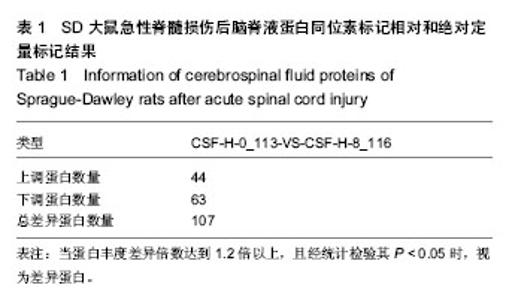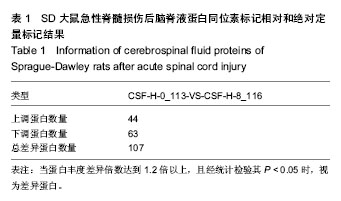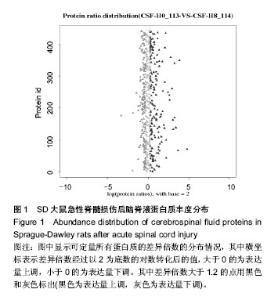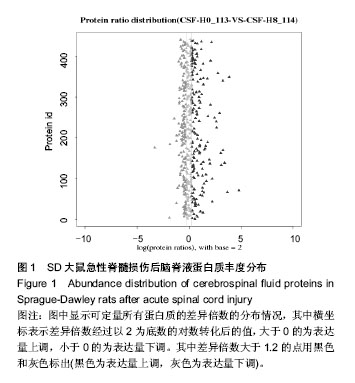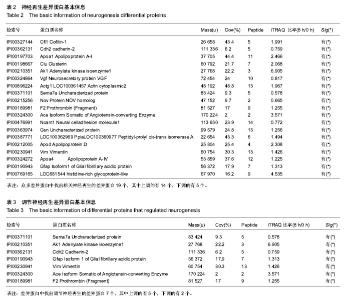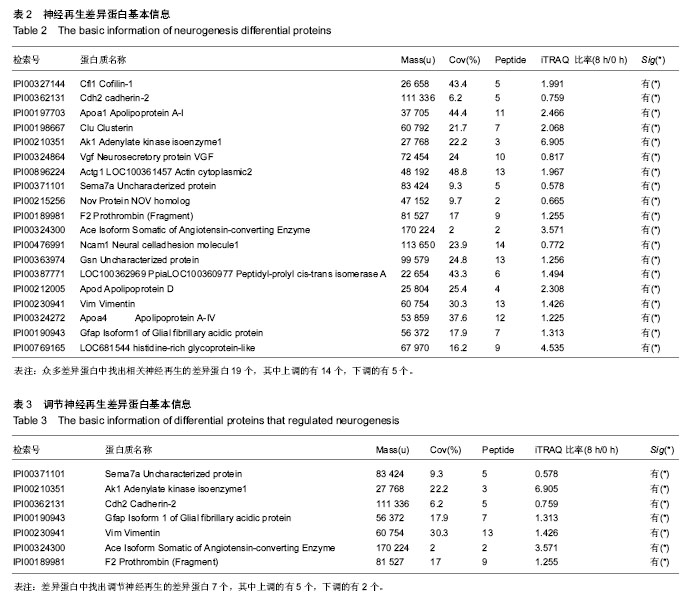| [1] 郑启新,汪健,郭晓东.急性脊髓损伤后神经保护的研究现状与展望[J].中华实验外科杂志,2012,29(7):1213-1216.
[2] Emery E, Aldana P, Bunge MB, et al. Apoptosis after traumatic human spinal cord injury. J Neurosurg.1998; 89: 911-920.
[3] Wyndaele M, Wyndaele JJ. Incidence, prevalence and epidemiology of spinal cord injury:what learns a worldwide literature survey?Spinal Cord. 2006;44(9):523-529.
[4] Tsutsumi S,Ueta T,Shiba K. et a1.Effects of the second national acute spinal cord injury study of hish-dose methylprednisolone therapy on acute cervical spinal cord injury-results in spinal injuries center.Spine.2006; 31(26): 2992-2996.
[5] Wise Yong,胥少汀,苟三怀.大剂量甲基强的松龙治疗急性脊髓损伤[J]. 中国脊柱脊髓损伤杂志,2000,10(5):304-305.
[6] Awad H, Suntres Z, Heijmans J. et al. Intracellular and extracellular expression of the major inducible 70kDa heat shock protein in experimental ischemia-reperfusion injury of the spinal cord. Exp Neurol.2008;212(2): 275-284.
[7] Boehm AM, Pütz S, Altenhfer D. et al.Precise protein quantification based on peptide quantification using iTRAQ. BMC Bioinformatics.2007;(8):214.
[8] 杨星,张纪阳,朱云平,等,基于稳定同位素标记与质谱分析的蛋白质定量算法研究进展[J].分析化学,2009,37(1);144-151.
[9] Wu WW, Wang G, Baek SJ .et al.Comparative study of three proteomic quantitative methods,DIGE,cICAT,and iTRAQ, using 2D gelor LC-MALDI TOF/TOF. 2006;5(03):651-658.
[10] Ross PL,HuangYN,Marchese JN,et al.Multiplexed protein quantitation in Saccharomyces cerevisiae using aminereactive isobaric tagsang reagents.Mol Cell Preteomics. 2004;3(12):1154-1169.
[11] Ross PL,Huang YN,Marchese JN,et al.Multiplexed protein quantitation in Saccharomyces cerevisiae using amine-reactive isobaric tagging reagents. 2004;3(12); 1154-1169.
[12] Trougakos IP, Djeu JY, Gonos ES, et al. Advances and challenges in basic and translational research on clusterin. Cancer Res.2009;69:403-406.
[13] Trougakos IP, Gonos ES. Regulation of clusterin/ apolipoprotein J, a functional homologue to the small heat shock proteins, by oxidative stress in ageing and agerelated diseases. Free Radic Res.2006;40:1324-1334.
[14] Wilson MR, Easterbrook-Smith SB. Clusterin is a secreted mammalian chaperone. Trends Biochem. Sci.2000;25:95-98
[15] Rizzi F, Coletta M, Bettuzzi S. Chapter 2: Clusterin (CLU): from one gene and two transcripts to many proteins. Adv Cancer Res.2009;104:9-23.
[16] James RW, Hochstrasser AC, Borghini I, et al. Characterisation of a human high density lipoprotein- associated protein, NA1/NA2. Arterioscler Thromb. 1991;11: 645-652.
[17] Zinkie S, Gentil BJ, Minotti S,et al. Expression of the protein chaperone, clusterin, in spinal cord cells constitutively and following cellular stress, and upregulation by treatment with Hsp90 inhibitor.Cell Stress Chaperones. 2013;18(6):745-758.
[18] Charnay Y, Imhof A, Vallet PG,et al.Clusterin expression during fetal and postnatal CNS development in mouse. Neuroscience. 2008;155:714-724.
[19] Van Beek J, Chan P, Bernaudin M,et al. Glial responses, clusterin, and complement in permanent focal cerebral ischemia in the mouse. Glia.2000; 31:39-50.
[20] Wiggins AK, Shen PJ, Gundlach AL. Delayed, but prolonged increases in astrocytic clusterin (ApoJ) mRNA expression following acute cortical spreading depression in the rat: evidence for a role of clusterin in ischemic tolerance. Brain Res Mol Brain Res. 2003;114(1):20-30.
[21] Charnay Y, Imhof A, Vallet PG, et al. Clusterin in neurological disorders: molecular perspectives and clinical relevance. Brain Res Bull. 2012;88(5):434-443.
[22] Polihronis M, Paizis K, Carter G, et al.Elevation of human cerebrospinal fluid clusterin concentration is associated with acute neuropathology.J Neurol Sci. 1993;115(2):230-233.
[23] Narayan P, Orte A, Clarke RW, et al. The extracellular chaperone clusterin sequesters oligomeric forms of the amyloid-beta(1-40) peptide. Nat Struct Mol Biol. 2011;19(1):79-83.
[24] Leeb C, Eresheim C, Nimpf J.Clusterin is a ligand for ApoER2 and VLDL receptor and signals via the Reelin-signalling pathway.J Biol Chem.2014;289(7):4161-4172.
[25] Bonnard AS, Chan P, Fontaine M Expression of clusterin and C4 mRNA during rat peripheral nerve regeneration. Immunopharmacology.1997;38:81-86.
[26] Ohlsson M, Bellander BM, Langmoen IA, et al. Complement activation following optic nerve crush in the adult rat. J Neurotrauma. 2003;20:895-904.
[27] Schreiber SS, Tocco G, Najm I,et al. Seizure activity causes a rapid increase in sulfated glycoprotein-2 messenger RNA in the adult but not the neonatal rat brain. Neurosci Lett.1993; 153:17-20.
[28] Rithidech KN, Honikel L, Milazzo M,et al.Protein expression profiles in pediatric multiple sclerosis: potential biomarkers. Mult Scler.2009; 15:455-464.
[29] Lidstrom AM, Bogdanovic N, Hesse C,et al. Clusterin (apolipoprotein J) protein levels are increased in hippocampus and in frontal cortex in Alzheimer's disease. Exp Neurol.1998;154:511-521.
[30] Navarro A, Méndez E, Diaz C, et al.Lifelong Expression of Apolipoprotein D in the Human Brainstem: Correlation with Reduced Age-Related Neurodegeneration. PLoS One. 2013 Oct 22;8(10):e77852.
[31] Thomas EA, Laws SM, Sutcliffe JG, et al.Apolipoprotein D levels are elevated in prefrontal cortex of subjects with Alzheimer’s disease: no relation to apolipoprotein E expression or genotype. Biol Psychiatry. 2003;54(2):136-141.
[32] Lim MC, Maubach G, Zhuo L. Glial Fibrillary Acidic Protein Splice Variants in Hepatic Stellate Cells - Expression and Regulation. Mol Cells. 2008;25(3):376-384.
[33] Blechingberg J, Holm IE, Nielsen KB, et al.Identification and characterization of GFAPkappa, a novel glial fibrillary acidic protein isoform. Glia.2007;55:497-507.
[34] Kamphuis W, Mamber C, Moeton M, et al.GFAP Isoforms in Adult Mouse Brain with a Focus on Neurogenic Astrocytes and Reactive Astrogliosis in Mouse Models of Alzheimer Disease. PLoS One. 2012;7(8):e42823.
[35] 向欣,黄其林.Semaphorin信号通路与细胞迁移[J].中华神经外科疾病研究杂志, 2011;10(5):477-478.
[36] Maurin JC, Delorme G, Machuca-Gayet I,et al.Odontoblast expression of semaphorin 7A during innervation of human dentin Matrix Biol. 2005;24(3):232-238. |
